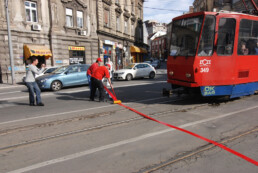VLADAN CARIČIĆ (1960)
Across the Red Thread
video
17’17”
1987–2012
The End of Red Thread
video
15’
2012–2014
Red Thread Crossing
video
6’36”
2012–2014
Across the Red Thread
video
17’17”
1987–2012
© Cultural Centre of Belgrade, the October Salon Collection and the artist
Gift Contract: III-5-293/1/29.9.2014.
Inventory No. 041
Photo: still from the video work
The End of Red Thread
video
15’
2012–2014
© Cultural Centre of Belgrade, the October Salon Collection and the artist
Gift Contract: III-5-293/1/29.9.2014.
Inventory No. 064
Photo: still from the video work
Red Thread Crossing
video
6’36”
2012–2014
© Cultural Centre of Belgrade, the October Salon Collection and the artist
Purchase Contract: III-5-520/24.12.2014.
Inventory No. 1392
Photo: still from the video work
The Ted Thread Trilogy consists of three video works made for the 53rd October Salon in 2012. The immediate inspiration were the spaces of Savamala and the Belgrade Cooperative Building, where the Salon was held, and the Salon’s slogan “Good Life”, which was so drastically in contrast with the reality of once the capital’s most beautiful area, then suffocated with traffic and bizarre contents. That is how the red thread was formed, a thin line stretched in space, which warns of invisible contents with the exciting forgotten history behind. Red Thread represents a thin, warning line between antipodes, the good and bad, the beautiful and ugly, the forgotten and marked without good reason.
With the work Across the Red Thread, Caričić returns to the Belgrade Cooperative Building, to the space where he made the film The Harms Case with some friends. Besides reconstructing of Harms’ film room, he felt a need to say something about the collapse of this significant Savamala space. So the red thread drew a line between the found run-down spaces and a possible “good life” if only as a set for the longest frame in Yugoslav cinematography, shot there a long time ago. Originally, Red Thread Crossing was created as a performance that Caričić, with his associates, carried out at the 53rd October Salon. A cross symbolically placed over the junction of five streets in front of the Belgrade Cooperative was a desire to finally break with ephemeral contents that suppressed once distinctive life of Savamala. Finally, The End of Red Thread, the last part of the Red Thread Trilogy, created at the moment of closing of the 53rd October Salon, represents a symbolic cutting of the “fateful” old beam, which poses a challenge to return the spirit of good events to the space of Savamala.
Selected Bibliography:
53rd October Salon, Good Life: Physical Narratives and Spatial Imaginations. Cultural Centre of Belgrade, 2012
ABOUT THE AUTHOR:
Vladan Caričić (1960, Belgrade, Serbia) is a film and TV scenographer and producer.
He has dedicated different periods in his personal and professional life to exploring the possibilities of transmitting visual information and illusion to viewers, as a TV reporter and Balkans correspondent for the Finnish Broadcasting Company in the late 1980s, as a production designer and as an author who reconstructs and evokes different periods in history. In his rich scenographic opus, he has realized some of the most-viewed shows ever broadcast in the region, such as the puppet TV series Never Sorry. He tried his hand in various genres – from the children’s series Tricks and Gimmicks to the first feature film produced by the Serbian Orthodox Church – Christmas Song and the historical comedy Black Gruja and the Stone of Wisdom. In the film The Harms Case, he sought to make the rundown and grey city of Belgrade into a fantasy of a post-revolutionary red Leningrad in the time of the avant-garde, that appeared and disappeared in an eye blink. He participated in the 53rd October Salon in Belgrade. Since 2012, he has been developing the Traveling Museum of New Primitivism Project with Sejo Sexon. At eight exhibitions of this museum, a number of art installations inspired by the New Primitive Movement have been realized (Zagreb, Ljubljana, Sarajevo, Tuzla, Banja Luka, Novi Sad, Belgrade). A co-author (with Siniša Žarin) of the exhibition Living in Danube Banovina, held at the RTS Gallery during the winter of 2014, which presented the concept of the Forgotten Arts Museum from Novi Sad.
